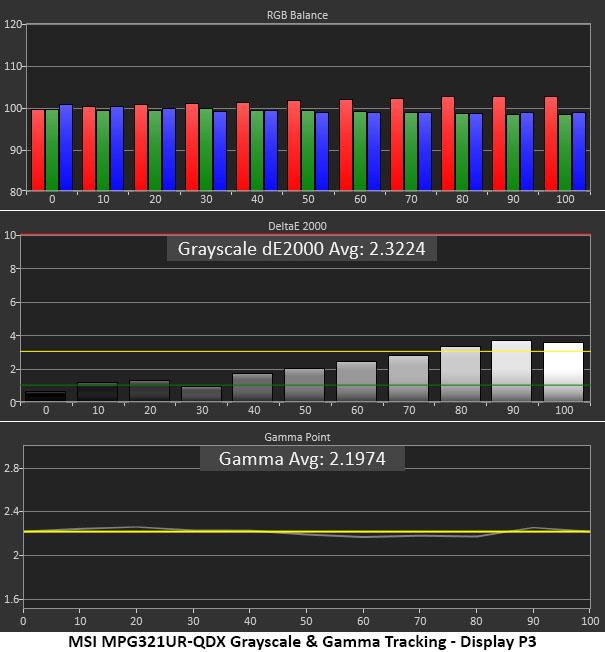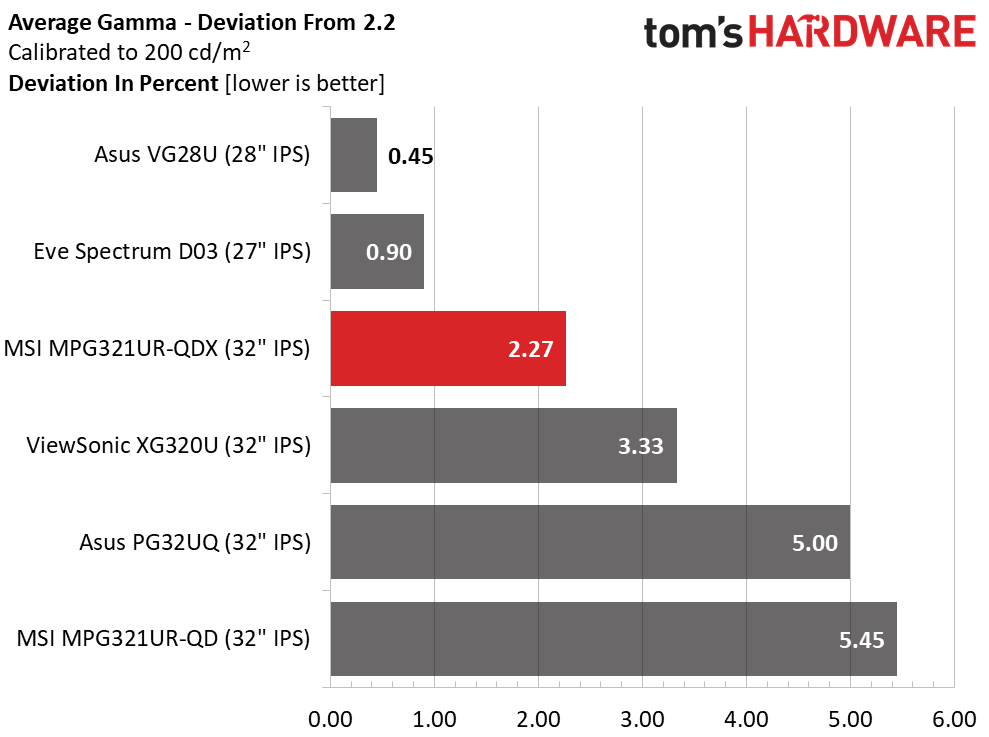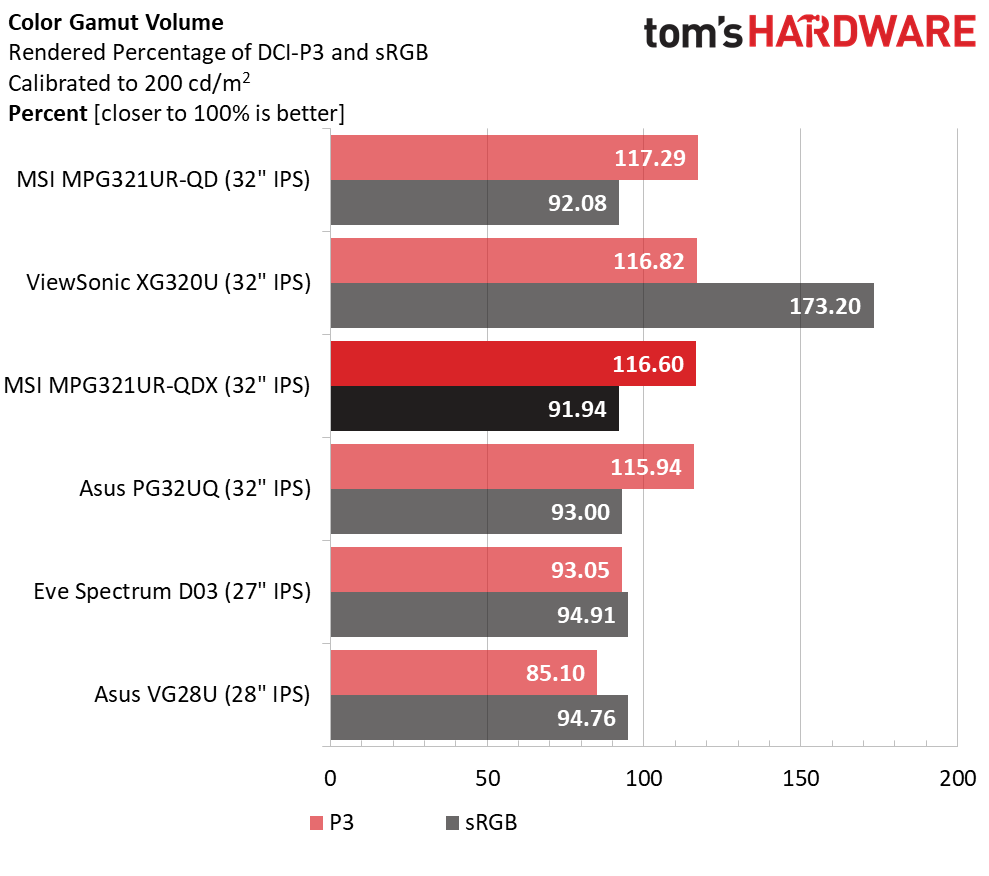Why you can trust Tom's Hardware
The MPG321UR-QDX is a fantastically color-accurate gaming monitor. It’s also flexible with options for every major gamut available in the Pro menu. You can dial up whatever palette you wish with a few clicks of the OSD joystick.
Grayscale and Gamma Tracking
Our grayscale and gamma tests use Calman calibration software from Portrait Displays. We describe our grayscale and gamma tests in detail here.




I started my tests at the MPG321UR-QD Xbox Edition’s default settings – Game Mode User and Pro Mode User. The full native color gamut is employed with gamma at 2.2 and the white point at 6500K. The initial grayscale run is visually perfect with no errors above 3dE. All but 100% are under 2dE for a low out-of-box average of just 1.32dE. It doesn’t get much better than that. Gamma tracks true with only a slight dip in the 50-90% range, something you won’t be able to see in real-world content.
I tried calibrating the MPG321UR-QD Xbox Edition, but the gain was minimal, and I couldn’t see a difference. What I could see was a significant drop in brightness. Selecting the Custom color temp reduced max output to just 143 nits. I observed the same behavior when I reviewed the original MPG321UR-QD. Since default grayscale and gamma are so good, I left the color temp set to Normal and measured the other gamut modes.
As you can see, sRGB, Adobe RGB and Display P3 all render a 6500K white point with 2.2 gamma. The differences between them are minor. I could see the barest hint of red in the brighter steps of a test pattern, but the actual content looked fine. This is excellent performance.
Comparisons




I charted the same values in the before and after results for the MPG321UR-QD Xbox Edition, 1.32dE. Calibration of the Custom color temp drops this value to 1.21dE which makes no visible difference in color and reduces brightness. The MSI wins the day for out-of-box accuracy and finishes fifth after the other screens are calibrated. The MPG321UR-QD exhibits nearly the same results.
The gamma result is a little better for the MPG321UR-QDX than its predecessor. The range of values is tighter, and it comes closer to a 2.2 average. The actual value I recorded was 2.15, which is also excellent performance.
Get Tom's Hardware's best news and in-depth reviews, straight to your inbox.
Color Gamut Accuracy
Our color gamut and volume testing use Portrait Displays’ Calman software. For details on our color gamut testing and volume calculations, click here.




The MPG321UR-QDX Xbox Edition could be called a DCI-P3+ monitor, but it is more accurate to term it a Rec.2020 display. Why? Notice the green targets. A DCI-P3 plot moves the line of green targets closer to yellow. The MPG321UR-QD Xbox Edition is clearly aiming at Rec.2020. That is the default gamut you’ll see when selecting User in the Pro Mode menu. It’s only a tad under-saturated but compared to nearly any other monitor, it’s much more colorful.
The other gamut options track even better with average values under 2dE. That’s pro-level performance that some professional displays struggle to match. The MPG321UR-QD Xbox Edition is a seriously good monitor when it comes to color accuracy.
Comparisons


Since DCI-P3 is the most common benchmark for measuring extended color monitors, I graphed the MPG321UR-QD Xbox Edition’s value for the Display P3 mode. Most users will use either this mode or User (full gamut) for SDR content, though sRGB would be the most accurate choice. Any way you slice it, this monitor delivers precise color. It is also a slight improvement over its predecessor.
In terms of gamut volume, the top four screens all perform about the same. The two MSI’s are slightly ahead, with the ViewSonic firmly in the mix. They could all be termed Rec.2020 monitors while the Eve Spectrum and Asus VG28U are DCI-P3 displays. If you want the biggest gamut currently available outside an expensive mastering monitor, the MPG321UR-QDX is it. If you select one of the gamut-specific modes, they are accurate enough for color-critical work.
Current page: Grayscale, Gamma and Color
Prev Page Brightness and Contrast Next Page HDR Performance
Christian Eberle is a Contributing Editor for Tom's Hardware US. He's a veteran reviewer of A/V equipment, specializing in monitors. Christian began his obsession with tech when he built his first PC in 1991, a 286 running DOS 3.0 at a blazing 12MHz. In 2006, he undertook training from the Imaging Science Foundation in video calibration and testing and thus started a passion for precise imaging that persists to this day. He is also a professional musician with a degree from the New England Conservatory as a classical bassoonist which he used to good effect as a performer with the West Point Army Band from 1987 to 2013. He enjoys watching movies and listening to high-end audio in his custom-built home theater and can be seen riding trails near his home on a race-ready ICE VTX recumbent trike. Christian enjoys the endless summer in Florida where he lives with his wife and Chihuahua and plays with orchestras around the state.
-
Leszek L. Hello!Reply
I am looking for a solution for PS5 and I am thinking about Inzone m9 or maybe something 32". This MSi looks nice. Is the quality of the image on both similar and difference only in size? Or maybe there is something else? Could you share your own choice, if you would have to make one?